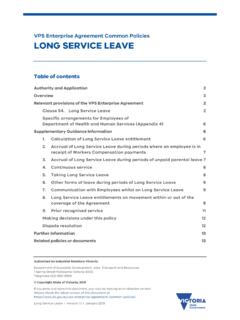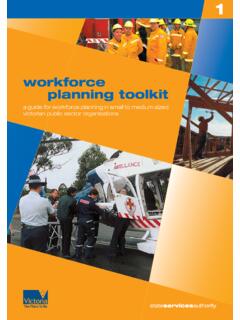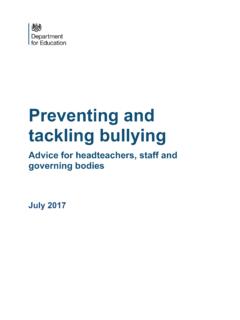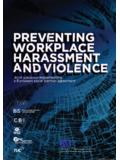Transcription of The case studies: turning the tide on bullying and poor ...
1 THE CASE STUDIESTURNING THE TIDE ON bullying AND POOR WORKPLACE CULTURESThe Victorian Government has vested the Victorian Public Sector Commission with functions designed to enhance the performance of the public sector fostering the development of an efficient, integrated and responsive public sector which is highly ethical, accountable and professional in the ways it delivers services to the Victorian key functions of the Commission are to: strengthen the efficiency, effectiveness and capabilityof the public sector in order to meet existing and emerging needs and deliver high quality services; and maintain and advocate for public sector professionalismand integrity. State of Victoria (Victorian Public Sector Commission) 2017 This work is licensed under a Creative Commons Attribution licence. You are free to re-use the work under that licence, on the condition that you credit the State of Victoria (Victorian Public Sector Commission) as author, indicate if changes were made and comply with the other licence terms.
2 The licence does not apply to any branding, including the Victorian Government logo and the Victorian Public Sector Commission queries may be directed to is turning the tide on bullying and poor workplace cultures: The Case Studies, version , published in May 2017. Subsequent versions may be published from time to time. Always check for updates at: Treasury Place Melbourne 3002 Email: Phone: (03) 9651 1321 THE TIDE ON bullying AND POOR WORKPLACE CULTURESTHE CASE .. case study Organisation ABe willing to send a strong message to your organisation .. case study Organisation B Walk the talk : the importance of leaders living the values .. case study Organisation CMaking sure every voice has the same volume .. case study Organisation D Communication, Communication, Communication .. case study Organisation ERedefining the symbols and rituals of organisation culture ..152 turning THE TIDE ON bullying AND POOR WORKPLACE CULTURESTHE CASE STUDIESINTRODUCTIONW orkplace bullying affects the health and wellbeing of staff and the productivity of organisations.
3 It is hard but not impossible to tackle. About 20 per cent of employees perceive bullying in their workplace, according to results from an annual survey of Victoria s public sector workers, the People Matter Survey. This rate has remained largely unchanged for more than 10 news on tackling bullying is not all bad. Some public sector organisations have managed to buck the trend and reduced perceptions of bullying in their organisations. The Victorian Public Sector Commission (VPSC) has obtained insights from five Victorian public sector organisations which have successfully reduced bullying rates over the last two to five years. These organisations represent a range of sectors, sizes and locations. Interviews and workshops were held with CEOs, human resource directors and staff in these organisations to better understand: the reasons for high rates of employee perceptions of bullying in the past; and the actions that led to a reduction in workplace report provides details on the journey taken by these organisations.
4 One thing is clear from these case studies: the journey has not been easy. It is also not over. A number of CEOs have acknowledged there is still work to be done to further improve workplace cultures. Others are aware of the possibility of bullying behaviours reappearing in their organisation and acknowledge this will need constant monitoring. The case study organisations have had varied experiences of bullying which include: bullying from a single individual, which had a wide impact across the organisation bullying by senior leaders in the organisation bullying behaviours occurring right across the organisation due to poor workplace cultures, or poor change management is common across all these organisations is that their approaches haven t solely been focused on tackling the specific issue of bullying . Leaders understand that bullying behaviours tend to stem from poor workplace cultures and that any strategy to reduce bullying has to be integrated with strategies to improve culture more broadly.
5 Key themes emerging from the case study organisations include the importance of: strong leaders who set the tone of what is acceptable in the organisation clear grievance processes training for staff to be aware of bullying and to self-resolve issues where appropriate encouraging respectful and positive workplace behaviours throughout the organisation investing in leaders to effectively manage and build harmonious teams clear and transparent communication, particularly during change building a positive organisational cultureWith close monitoring of bullying behaviours and a commitment to building better organisational cultures, the chances of these organisations mitigating or preventing bullying altogether is better than ever. These stories may help your organisation turn the tide on bullying too. 3 turning THE TIDE ON bullying AND POOR WORKPLACE CULTURESBULLYING CASE STUDYORGANISATION AORGANISATIONABE WILLING TO SEND A STRONG MESSAGE TO YOUR ORGANISATION Organisation A , a Melbourne based organisation with fewer than 100 staff, had its bullying levels peak in 2014.
6 One in five staff reported they had experienced bullying . By 2016, this figure had plummeted from 20 per cent to 7 per cent. This case study tells the story of how not dealing with bullying early can lead to severe consequences for an organisation. However it also tells us how taking strong action against bullying is a critical start to mending poor workplace cultures. It demonstrates the importance of a workplace that is built on values such as mutual respect, trust and collaboration. It is based on interviews with the Chief Executive Officer (CEO), Human Resources (HR) director and other PROBLEMI ssues of bullying in the organisation came to a head in late 2013 within weeks of the current HR director joining the organisation. bullying behaviours had been surfacing in the organisation for some time. While some action had been taken on complaints, they were not handled systematically. The organisation dealt with single incidents rather than seeing a pattern of behaviour.
7 The organisation had just finished a significant restructure and the previous HR director had been appointed to lead this change. The CEO said the restructure process was complex and managing individual bullying issues was particularly difficult at the time. The current HR director was appointed once the restructure was complete to help the organisation to focus more on its case study focuses on one major case of bullying where a manager was both aggressive and intimidating to staff. Their behaviour worsened the longer it was not addressed. Staff reported that the perpetrator targeted women and used offensive language. As the bullying started to escalate, further reports of serious misconduct emerged. The bullying behaviour increased and tensions started to rise. Some staff stopped coming to team meetings if the perpetrator was going to be present. Staff would also avoid discussing work with the perpetrator and would instead go straight to the perpetrator s team members.
8 The HR director said that the behaviour from the perpetrator led to many staff losing confidence in their ability to do their jobs. THE CATALYSTAs complaints started coming to the new HR director, the CEO and HR director started a formal investigation, which substantiated a number of allegations. The perpetrator was then dismissed. This started a year-long arbitration process for the organisation. The perpetrator lodged an application for documents under the Freedom of Information Act 1982 to obtain information to use as part of a planned unfair dismissal submission to the Fair Work Commission. The organisation obtained legal advice and collected statements from staff who had experienced bullying as it prepared its response. The organisation eventually settled with the perpetrator before the case was put forward to the Commission but not before the organisation, and particularly the HR director, had invested substantial time and work in preparing to defend against any unfair dismissal action.
9 4 turning THE TIDE ON bullying AND POOR WORKPLACE CULTURESBULLYING CASE STUDYORGANISATION ARESPONSE AND REFLECTIONS1BE READY AND WILLING TO TAKE STRONG ACTION WHEN NEEDEDThe CEO does not regret embarking on the challenging process of investigating and dismissing the perpetrator. She wanted to send a strong message that certain behaviours would not be tolerated, regardless of any individual s senior the CEO and HR director could not directly inform staff of what was happening, staff suspected the organisation had taken firm action, given the perpetrator was removed. The HR director said: Staff were coming into my office and saying, I don t know what you did, but I know you did something, so thank you! 2 BUILDING TRUST IS THE KEY TO IDENTIFYING bullying EARLYThe HR director said because reports of bullying had not been addressed before she arrived, there was no confidence or trust in the process. Staff reported that in the past, they were made to feel like they were the problem, with suggestions they undergo resilience training to be able to better deal with the situation.
10 Others felt that the perpetrator s behaviour had almost become normalised, with everyone getting the same treatment . Because no action was taken, people stopped reporting the misbehaviour. The HR director placed a focus on building relationships with staff so more employees were willing to speak with her about bullying issues. She said at times, staff had come to her to report what they thought was bullying behaviour but was actually a misunderstanding that was sorted out through a conversation between her and the other staff involved. Staff said they were comfortable talking to the new HR director about a range of issues. There is more trust in the way the organisation deals with bullying , with bullying and misconduct issues not left to fester. 3 NEW WORKPLACE BEHAVIOURS POLICIESThe new HR director developed new workplace behaviour policies, focusing on the organisation s values and behaviours. These set out the behaviour expected of staff, explained the grievance process, and encouraged self-resolution among staff where organisation ran multiple training sessions to teach staff how to identify bullying and to empower them to self-resolve issues.








